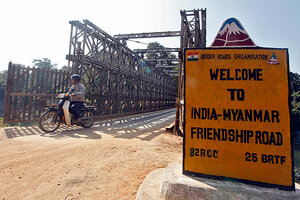Doubts emerge over Indian Army 'hot pursuit' into Myanmar
India claimed to kill many rebels in Myanmar and said its cross-border raid was facilitated by Myanmar's government. Both claims appear shaky.

A man rides his motorized two-wheeler across the Indo-Myanmar border bridge at the border town of Moreh, in the northeastern Indian state of Manipur, 2012.
Rupak De Chowdhuri/Reuters/File
Kolkata, India
Earlier this month the Indian Army suffered its deadliest ambush in nearly 30 years. Heavily armed rebels in the remote northeast state of Manipur killed at least 20 soldiers, then fled across the border into neighboring Myanmar, a common tactic.
Five days later India announced a successful cross-border Army raid. Special commandos had killed nearly 40 rebels in two bases, “deep in another country,” a government spokesman told reporters. New Delhi officials crowed that the June 9 incursion was made possible by “friendly relations” with Myanmar.
The front-page news stirred pride among Indians – and disquiet among its neighbors. Rajyavardhan Rathore, an Indian press minister and former Army colonel, said the strikes were a message to all nations and to groups harboring “terror intent” toward India that “we will strike at a place and at a time of our choosing.”
Arch-rival Pakistan bristled at the news, warning India it wouldn't stand for any similar violations of its sovereignty. “Those who have evil designs against us, listen carefully. Pakistan is not Burma," Pakistan's interior minister, Chaudhry Nisar Ali Khan, said in a statement.
Now, India's story of a full-bore military incursion into Myanmar has been called into question. Human rights activists returning from the scene in Myanmar after talking to local villagers report finding no evidence of the “significant casualties” of rebels the Army claims to have inflicted.
Respect for sovereignty
Moreover, India appears to have overstated the willingness of Myanmar's government to look the other way and allow India to engage in cross-border hot pursuit. After the June 9 raid, the chief of staff to Myanmar President Thein Sein, a retired Army general, called for “every country to respect…sovereignty.”
India has repeatedly asked Myanmar to clean up the rebel camps, but to little of no avail; dozens of ethnic and tribal militants straddle the lawless borderlands. A week after the incursion, both India’s foreign secretary and national security advisor visited Myanmar to smooth relations, but reportedly failed to clear a new proposal by Delhi for joint military action inside Myanmar.
While the region is remote, there is plenty of traffic across the border; various groups have since visited the area where the incursion took place. One rights activist from Manipur, Debabrata Roy Laifungbam, talked to villagers on both sides of the border, joining an Indian Red Cross Society team.
“All local people we met…said that Indian soldiers had indeed launched a military operation inside Myanmar on June 9. But, it did not result in any casualty in the area, they all confirmed,” according to Dr. Laifungbam, president of an indigenous people’s NGO. “Villagers … heard gunshots on the morning of June 9 and found the camps had been fired upon and destroyed by Indian soldiers."
Yet the destruction of the camps did not result in fatalities, according to these villagers. “Even an injury of a rebel cannot go unnoticed … We spoke to different villagers at different places. They all confirmed that the rebels had not been fired upon by Indian soldiers on June 9,” Laifungbam says.
Rebel casualties in doubt
Col. Rathore told reporters on June 9 that, “such attacks [like the Manipur ambush] will no more be tolerated. It was a historic and very brave decision by the Prime Minister to go in hot pursuit and annihilate the rebel camps. And, that’s exactly what was done.”
Authorities did not say how many rebels were killed, but Indian media quoted unnamed defense officials relaying a tally of 38; one newspaper, citing the home ministry, said the incursion may have killed more than 100 Indian rebels. However, Laifungbam says villagers in Sagaing, near the Myanmar rebel camps, were taken aback when told of these claims.
The rebels have formed an umbrella group called the United National Liberation Front of West South East Asia. One major faction is the National Socialist Council of Nagaland-Khaplang (NSCN-K), a separatist group.
A NSCN-K leader quickly dismissed the Army account of the June 9 incursion as “completely false,” according to the Nagaland Post. The NSCN-K is now asking Indian authorities to produce any evidence, including bodily remains, that would support their claim of a military success.
Three other groups from Manipur and Assam in northeast India who have their camps in Myanmar, have also refuted the claims, issuing a statement calling the story “false and cheap propaganda to boost the morale” of India's soldiers.

